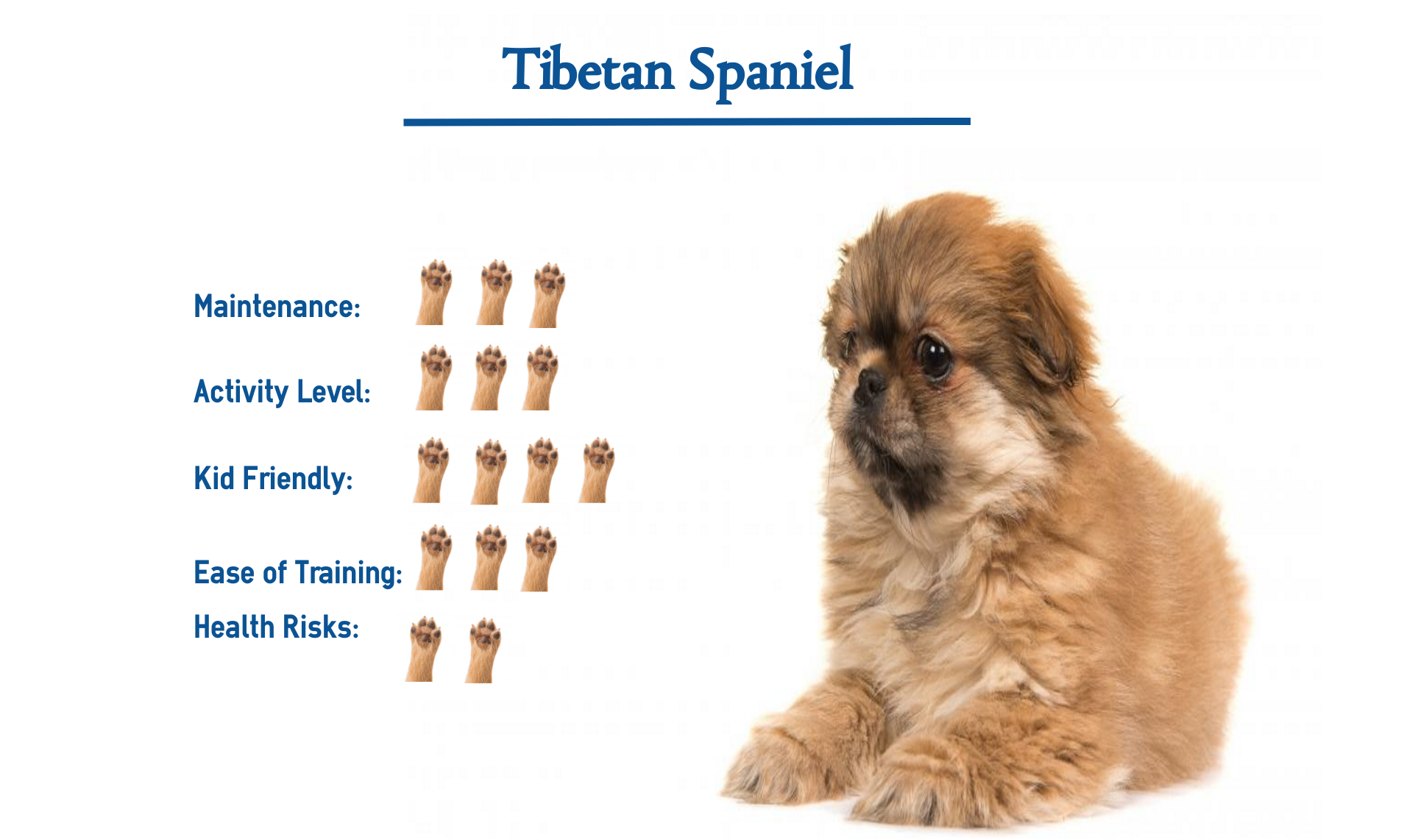From one of the most beautiful terrains in the world, it’s no wonder the Tibetan Spaniel is such a cutie. But like the prayer wheels of Tibet, they may be nice to look at or even use, but they are not always something you can keep at home.
This is why…
We wanted to take a moment and discuss this fantastic dog breed in greater detail so that if you’re ever allowed to make one of these dogs your own, you’ll know for sure whether or not that’s going to be a good idea. Because who knows, it is possible that perhaps a Tibetan Spaniel isn’t the “perfect” fit, but a Tibetan Terrier or a Lhasa Apso is! Who knows?
So, without further ado, let’s dive right in!
Tibetan Spaniel Fast Facts
Country of Origin: Tibet / China
Original Purpose: Companionship and watchdogs
Height: 10 to 14 inches at the shoulder
Weight: 10 to 15 pounds
Lifespan: 11 to 15 years
Breed Type Classification: watchdogs
Lifespan: 11 to 15 years
Nickname: Tibbie
Origin of the Tibetan Spaniel
This dog is from ancient Tibet, and most people believe that Buddhist monks (called lamas in their region) used these little pups as watchdogs or “alarm dogs.”
What is known is that…
They were bred in Buddhist Tibetan monasteries throughout Tibet, including the Himalayan mountains. And that they were highly treasured. These little guys were considered “royal dogs” and were commonly gifted to VIPs and dignitaries worldwide. The best puppies were, of course, the best presents.
This is mainly how…
These little guys could migrate out of their isolated homeland and travel worldwide. But even though they were commonly “gifted” to folks worldwide, it still took some time before the “West” became familiar with these little guys.
This is why…
It wasn’t until the late 1950s that these little guys became acknowledged outside Tibet by two separate dog associations, including the Tibetan Spaniel Association of England and the England Kennel Club. It wasn’t until 1983 that the American Kennel Club (AKC) finally decided to “officially” recognize the breed.
Physical Characteristics
It’s hard not to look at this tiny dog and immediately think, “Dog in a lion costume.” They look like that, right (and if you didn’t see it before, you probably do now). They have a curly tail with long hair on it. Their overall hair is wispy but soft. Usually, these dogs are brown on top, with some black here and there. The stomach and neck tend to be white. The ears of a Tibetan Spaniel are like any dog drawn by a child (or even the pup emoji) – short yet floppy and squared off. He’s so cute!
Personality and Temperament
Some people may call this a cat-like dog. The reference generally means not that cuddly, aloof, and independent. So, if you’re a cat person and the thing you’ve hated about dogs is their clingy nature, then maybe a Tibetan Spaniel is the dog you’ve been waiting for your whole life.
And We’ve got to admit…
They are, like a lot of cats, actually quite friendly to those they love. They will give affection to those near and dear but will be a bit aloof to strangers. This dog is pretty small, and if you travel around Asia, you can see this dog hanging out in purses and bags a lot. But we should point out that this dog doesn’t like to be left alone. Separation anxiety is natural, especially for this dog. Another thing to remember is that this dog isn’t all that big on exercise. If you’re looking for a dog to walk by your side at the park daily, then Tibbies aren’t for you.
Comparable Breeds
This dog is often compared to the Japanese Chin or Pekingese. If you can’t find a Tibetan Spaniel, those are two others to consider. You may also think about a Shih Tzu or a Pug, though physically, a pug is different!
Potential Health Concerns
These puppies and adult dogs are generally healthy. Of course, they can be predisposed to specific problems, particularly if the breeders haven’t taken extra care during the breeding process (even if they have). Some of the most common problems that a Tibetan Spaniel could have are:
- Progressive Retinal Atrophy – if not taken care of, the dog could go blind
- Allergies – these could be food-related or debris (pollen, dust, etc) stuff
- Patellar Luxation – eventually, you will likely have to get surgery for this issue. Remember, this can be costly!
And while…
Many of these conditions may not be life-threatening, but they can become quite expensive, particularly if they become recurring issues. This is why we here at IndulgeYourPet also recommend that any new pet owner take a moment and see what it might cost for you to purchase a pet insurance policy for your new animal.
Now will a pet insurance policy be suitable for everyone?
No, probably not. But until you fully understand what these policies “will” and “won’t” cover and how much these pet insurance policies cost, how will you know if one might be right for you?
For more information on who we feel currently offers the “best” pet insurance policies out there, we would encourage you to check out our Best Pet Insurance Policies article.



